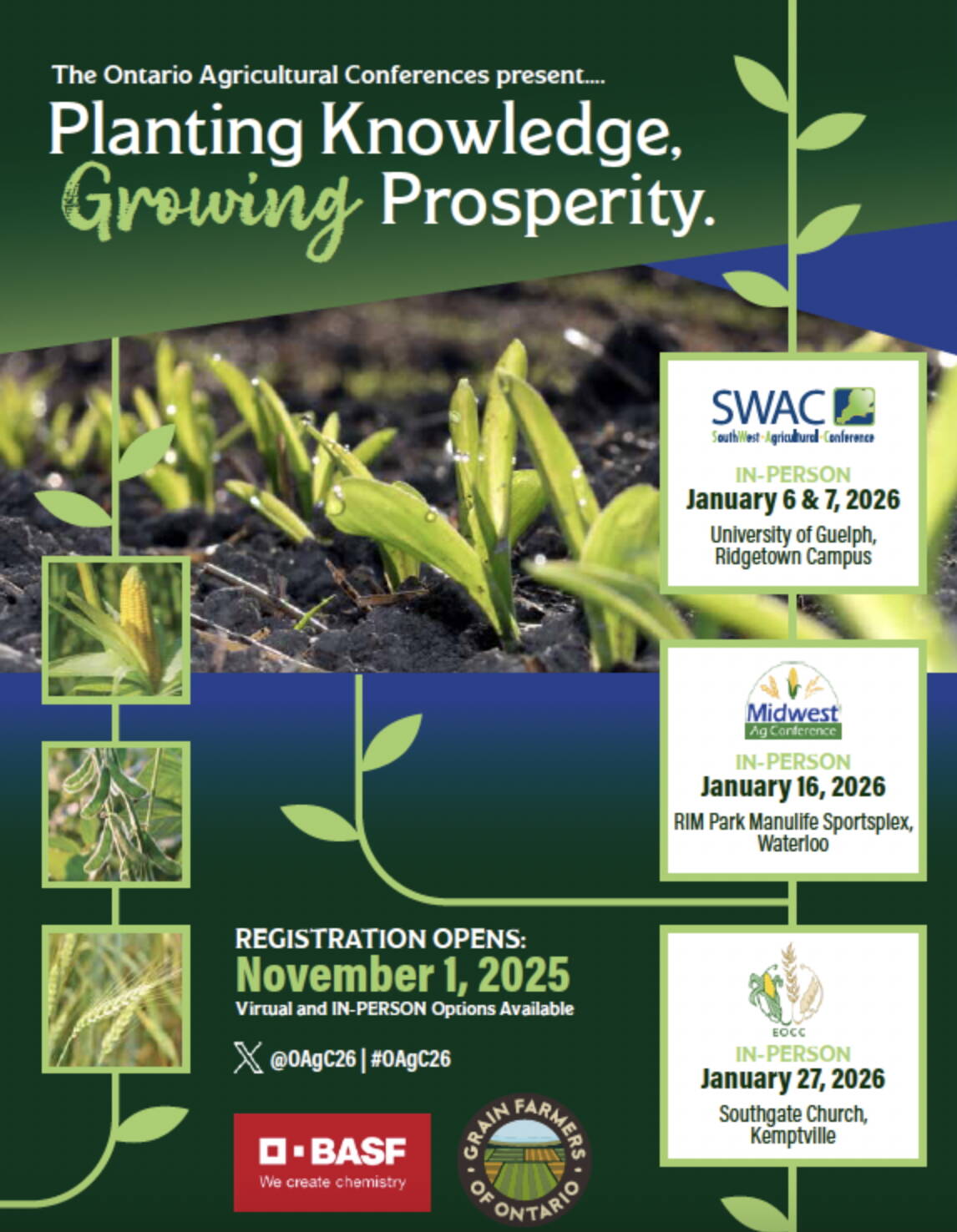Ontario wheat, corn and soybean prices came under pressure in early January due to steady farmer selling and a stronger Canadian dollar. The freeze-up of the lake system tends to result in basis deterioration for commodities moving east. Producer selling will ease later in winter and export demand will improve for all grains and oilseeds.
Quick look
Soybeans: Continued extreme weather in Brazil is making production forecast estimates difficult.
Corn: Domestic usage is at a seasonal high and export demand has slowed.
Wheat: Ontario winter wheat is vulnerable to winter-kill due to warm winter temperatures.
During January through March, the fundamental focus slowly turns from old crop demand to new crop supply projections. We continue to project a historically tight on-farm carryout for Ontario soybeans.
Read Also

Registration open for Ontario Agricultural Conference
The Ontario Agricultural Conference 2026 offers in-person and online access to expert insights, hands-on learning, and networking opportunities.
The market is encouraging acreage for 2024. We’ve bumped up our 2023-24 export projection for Ontario corn and producers will likely trim corn acres this spring.
The Ontario winter wheat crop is vulnerable to winter-kill due to warmer temperatures and limited precipitation. Statistics Canada will release its Dec. 31 Stocks of Principal Field Crops on Feb. 8. These reports are important because they confirm the 2023 production estimate and provide information on domestic feed use for crops like corn and wheat.
A year-over-year decline is expected for Brazil’s soybean crop. Actual acreage is uncertain and adverse weather continues to cause yield drag. Argentine soybean production is set to double last year’s output. We’re expecting a sharp year-over-year increase in U.S. soybean acres.
Brazilian corn production estimates are all over the map but the year-over-year decline may be as large as 20 million tonnes. The Argentine corn crop is developing under favourable conditions. U.S. farmers will decrease corn acres this spring, which will significantly tighten the corn fundamental structure.
The trend in North American weather is below average precipitation and above normal temperatures. We’ve never lost a crop in January but we could see new crop prices incorporate a risk premium due to uncertainty in production.
The Canadian dollar experienced a surprising bounce in December, reaching 76 cents US. The financial industry believes that monetary tightening from the U.S. Federal Reserve and the Bank of Canada is near or at the end.
The hard landing for the Canadian economy may be cushioned from stronger expected economic growth south of the border. Unrest in the Middle East has resulted in firmer crude oil prices, which has been supportive for the Canadian dollar. The negative outlook for the Canadian dollar has evaporated and we have a neutral outlook for the resource-based currency.
Soybeans
The January through March period can be slow for the Ontario soybean market. Ontario on- farm stocks as of Dec. 31 are estimated at one million tonnes, while supplies in commercial positions are estimated at 1.1 million tonnes.
From Jan. 1 through March 31, Ontario domestic demand is estimated at 450,000 tonnes, while exports are estimated at 550,000 tonnes. Ontario farmers tend to sell 500,000 tonnes during this three-month period. There is no strain on the pipeline given steady producer selling and larger commercial supplies.
By March 31, Ontario on-farm stocks will drop to 500,000 tonnes, while commercial supplies will also be around 500,000 tonnes. Supplies in commercial positions tighten during the late spring and summer period. During April and May, the market needs to pull stocks from the farmer. Given this fundamental projection, we don’t want to be overly aggressive on sales recommendations from January through March.
Brazil continues to experience extreme weather, making it difficult to forecast production. Early in January, some planting was still underway in Mato Grosso do Sul. Early maturing soybeans were being harvested in other parts of Brazil. Trade estimates range from 150-155 million tonnes, down from the USDA forecast of 161 million tonnes and down from last year’s output of 160 million tonnes.
Traders are comfortable with the Argentinean soybean estimate of 48 million tonnes, up from last year’s crop of 25 million tonnes.
The increase in Argentinean soybean crop has been bearish for soymeal and soy oil prices. The increase in palm oil output has caused palm oil prices to hover at two-month lows. This is negative for the vegetable oil complex.
During the first week of January, Brazilian soybeans were offered at US$495/tonne f.o.b. Paranagua, while U.S. soybeans were quoted at $508/tonne f.o.b. the Gulf. Export offers in both countries are down $7/tonne from 30 days earlier.
U.S. soybean export sales are running 15 per cent behind last year and this coincides with the USDA’s export forecast. The USDA is expecting a 12 per cent year-over-year decline in U.S. soybean exports.
U.S. farmers are expected to plant 87.6 million acres of soybeans this spring, up four million acres from last year. Using a trend yield, production has potential to reach 120.5 million tonnes, up from the 2023 crop of 112.4 million tonnes and up from the five-year average of 113.8 million tonnes. Weather is uncertain and the yield forecast may be optimistic. Farmers need to be aware that traders have a bearish outlook for new crop soybeans.
What to do: We’ve advised Ontario farmers to be 50 per cent sold on their 2023 production. At this stage, we’re expecting Ontario farmers to plant 3.1 million acres of soybeans this spring, up from 2.9 million acres last year and up from the five-year average of three million acres.
There is still significant growing season left in South America. An increase in U.S. acreage may not be enough to offset lower yields if adverse weather materializes. We’re not making new crop recommendations at this time.
Corn
Ontario corn prices are marginally lower than last month. Export demand slows during the winter. However, lower export movement is offset by seasonal strong domestic feed usage.
Ontario on-farm stocks as of Dec. 31 are expected to come in at 3.6 million tonnes, down from the year-ago level of 4.3 million tonnes. Commercial stocks as of Dec. 31 are forecasted to be 4.1 million tonnes, unchanged from 12 months earlier.
Given lower on-farm stocks on Dec. 31, the domestic market will function to ration demand by trading at equal or higher values than the export market. Look for domestic basis level appreciation from April through June.
Ontario on-farm stocks as of Aug. 31, 2024, are expected to drop to 350,000 tonnes, down from the Aug. 31, 2023, number of 497,000 tonnes and down from the five-year average of 890,000 tonnes. On-farm corn stocks in Ontario at the end of the 2023-24 campaign have potential to be historically tight.
Trade estimates for Brazilian corn output range from 110 to 122 million tonnes. This compares to the USDA number of 129 million tonnes and last year’s output of 137 million tonnes. Brazil’s first corn crop will likely finish in the range of 18-20 million tonnes.
The second crop known as the Safrinha production will only be planted in late February due to the delayed soybean harvest. Safrinha output is expected to finish from 95 to 105 million tonnes. This crop is usually harvested in June but given the later planting date, it will be harvested in July. The bulk of the exportable surplus comes from the second corn crop.
The Argentine corn crop is on track to reach 55 million tonnes, up from 34 million tonnes last year. The bulk of the Argentinean crop is harvested in May.
At the time of writing this article, U.S. corn was offered at $208/tonne f.o.b. the Gulf, while Brazilian corn was quoted at $229/tonne f.o.b. Paranagua. U.S. corn export sales are running 35 per cent ahead of last year. The U.S. will be the main supplier on the world market until July.
Cattle on feed inventories in Ontario, Alberta and the U.S. are at seasonal highs during March and April. U.S. ethanol production is running higher than expected. The point is domestic usage is at a seasonal high when the U.S. is the driver of the world market.
More importantly, U.S. farmers are expected to plant 90 million acres of corn this spring, down 4.9 or 5.2 per cent from the 2023 planted area of 94.9 million acres.
What to do: Our strategy is unchanged from the previous issue. Farmers should be 40 per cent sold on their 2023 production. Ontario farmers are expected to plant 2.2 million acres of corn this spring, which is marginally lower than last year but unchanged from the five-year average. This comes on the heels of the lower on-farm stocks forecast. World fundamentals favour price strength in March and April. The U.S. cannot afford a weather problem given the lower acreage or we will see significantly higher prices in the spring.
Wheat
The Southern Hemisphere harvests are in the final stages, while the Northern Hemisphere winter wheat crops are in dormancy. The wheat market is focused on demand for the time being. This typically results in a softer tone for the wheat complex.
Having said that, the wheat market remains vulnerable to geopolitical risks. Tensions continue to build in the Black Sea, threatening grain shipments out of Russia and Ukraine. The exportable surplus from Russia is shrinking and we’re expecting offers out of the Black Sea ports to increase later in spring.
Unrest in the Middle East has resulted in a military build-up in the Red Sea and surrounding areas. There will be major tenders from the Middle East during February and March as Egypt, Saudi Arabia and others look to build up supplies.
The Ontario winter wheat crop is vulnerable to winter-kill due to below normal precipitation and above normal temperatures. Farmers planted 1.009 million acres of wheat during the fall of 2023. Trade estimates suggest that there will be 159,000 acres of winter-kill, resulting in remaining acreage of 850,000.
Using an average yield, Ontario winter wheat production is expected to come in at two million tonnes, down from the 2023 output of 2.7 million tonnes.
Ontario farmers sold an estimated 2.3 million tonnes of wheat during the first five months of the crop year. Ontario on-farm wheat stocks as of Dec. 31 are expected to come in at 800,000 tonnes, up from the Dec. 31, 2022 supplies of 425,000 tonnes. The Ontario wheat market has been functioning to encourage demand. Domestic millers are well covered into spring; therefore, elevator prices are based on the export market.
During the first week of January, U.S. soft red winter wheat f.o.b. the Gulf was offered at $269/tonne. French soft wheat was valued at $248/tonne f.o.b. Rouen. Ontario soft red was quoted at US$250/tonne f.o.b. St. Lawrence port.
The USDA will release its winter wheat planting survey later in January. We’re expecting U.S. soft red winter wheat acres to come in at six million, down from the 2023 planted area of 7.6 million. The five-year average is also six million. Production has potential to finish in the range of eight to 8.5 million tonnes, down from the 2023 crop size of 12.2 million tonnes.
We’re also expecting a 10-12 per cent year-over-year decline in U.S. hard red winter wheat acres. Conditions for U.S. winter wheat are considerably better than last year but the main state of Kansas remains on the drier side.
In Europe, German winter wheat acres are expected to be down seven to eight per cent, while a year-over-year decline of 10 per cent is expected in France. Extensive rains during the fall hindered planting progress. Russia experienced favourable planting conditions this past fall and acreage is similar to the previous year.
The USDA had Australian output at 24.5 million tonnes, down from 40.55 million tonnes last year. There are quality issues in some regions. Traders are comfortable with the Argentine crop size of 15 million tonnes, up from 12.5 million tonnes last year.
What to do: We’ve advised farmers to sell 60 per cent of their 2023 production. Let’s be patient to make the next sale. The U.S. and Europe have decreased winter wheat acres. This comes on the heels of a smaller Australian crop. Russia exportable surplus is declining. Geopolitical risks could enhance wheat prices later in spring.















